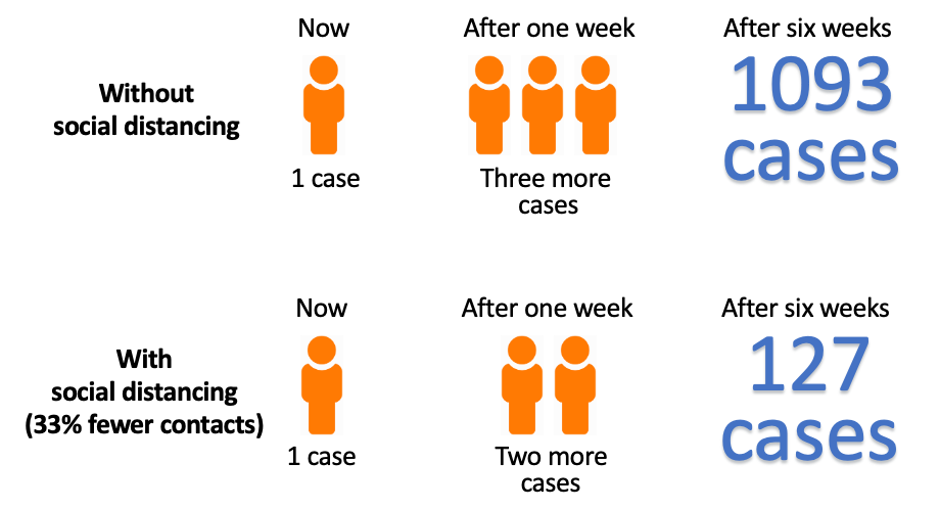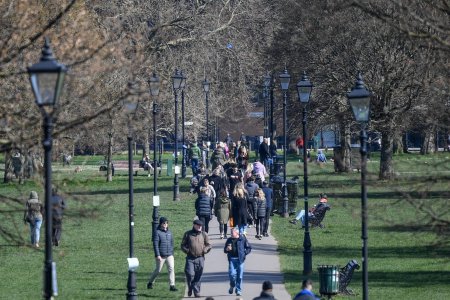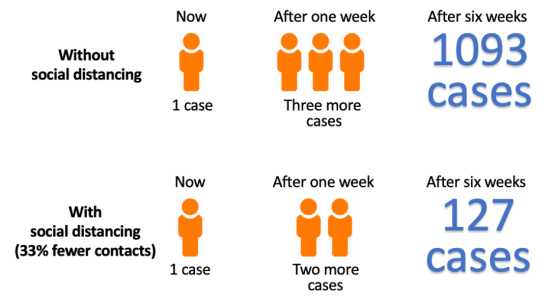Social distancing measures to reduce the spread of the novel coronavirus are in place worldwide. These guideline are for everyone. We are all expected to reduce our contact with others, and this will have some negative impacts in terms of mental health and loneliness, particularly for the elderly and other vulnerable groups. So why should we follow measures that seem so extreme? The answer is simple. Social distancing works. It reduces transmission of the virus effectively and lessens the impact on already stretched healthcare services. Oxford Mathematics's Robin Thompson explains.

"To illustrate this point, we can consider the effect that a social distancing strategy can have. Without these measures, an individual with COVID-19 can be expected to infect around three others over the course of their infection. One “generation” of infection takes around one week. So after one week, one infected individual will have become four infected individuals (the original infected, plus the three individuals they have infected). After a further week, each of the three new infected individuals can be expected to cause three new infections, leading to 13 infections in total. This compounding effect continues, so that after six weeks the initial infected individual will have started a chain of transmission that has led to over one thousand infections.
In contrast, however, if everyone in the population reduces their contacts by one third, then each infected individual will only infect two others over the course of their infection. This means that after one week, there will be three infected individuals in total. This is similar to the first scenario. But, after six weeks, if everyone reduces their contacts by one third, the chain of transmission will have caused 127 infections. While this is still a large number of infected individuals, it is substantially fewer than the scenario of over one thousand infections that occurs without social distancing.
Of course, widespread control measures have major effects on our lives. A colleague of mine in China – where case numbers have now fallen dramatically due to severe interventions – described to me how he had his temperature taken whenever he was driving his car on the highway as part of a “spot check”, and how he has to apply for a permit to even walk across his university campus. Measures like those may not be enforced in the same way in the west. But, if everyone adopts them, social distancing efforts here to reduce transmission can still be expected to have significant effects. Social distancing is particularly important because we do not know how much transmission is occurring from individuals displaying no or few symptoms. As a result, we should not try and self-determine whether or not we pose an infection risk. Instead, we should all take social distancing seriously, and support each other to follow these guidelines during this challenging time.
The handling of this pandemic worldwide has not been perfect. Only a couple of weeks ago, Donald Trump stated that COVID-19 is no worse than influenza, despite the fact that it has been clear to experts for weeks that the death rate is ten times higher than either seasonal flu or the H1N1 “swine flu” virus that swept around the world in 2009. But let’s face it – when this virus surfaced in early January, none of us could have imagined the scenario we are in now. The best thing we can do going forwards is put these things behind us. This novel coronavirus will continue to have an impact over the next weeks and months, and possibly beyond that. While looking out for one another, particularly those in vulnerable groups, we should do everything we can to stop this virus. Social distancing is of clear public health importance."
Robin Thompson's work focuses on using mathematical models to represent the epidemiological or evolutionary behaviour of infectious disease outbreaks. He has made many media appearances in recent weeks as the world grapples with the implications of the Coronavirus. In January he produced an early case-study on the potential of the virus. And on 23 March he gave an interview to ITV News where he expanded on the points in this article.



